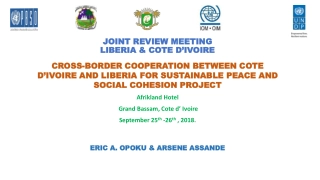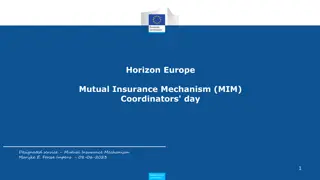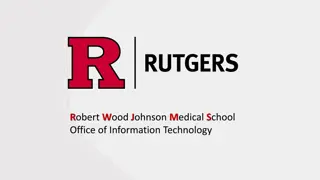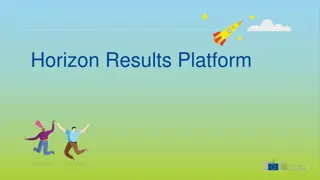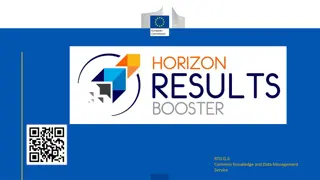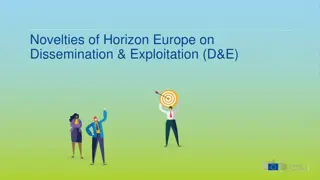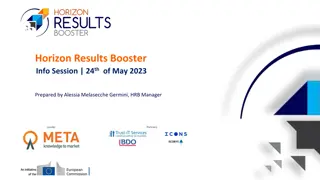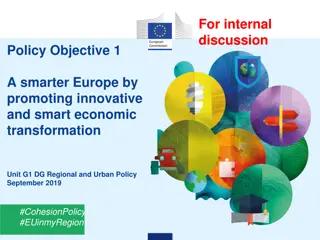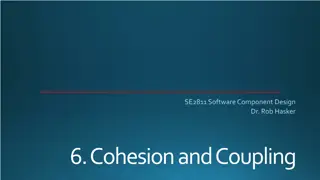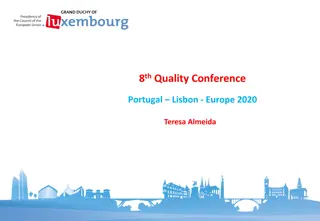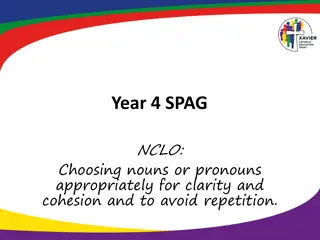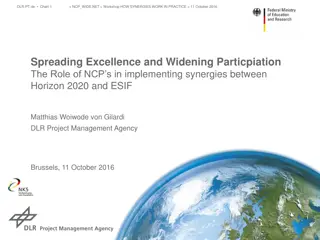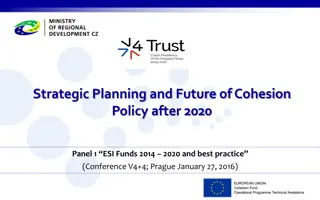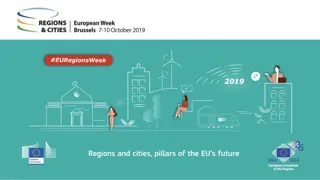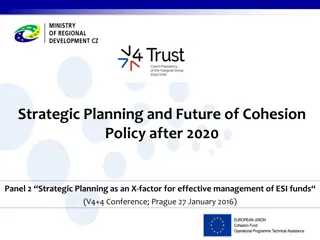Understanding the Interactions between Horizon 2020 and Cohesion Policy
Explore the dynamic relationship between Horizon 2020 and Cohesion Policy, focusing on how they complement each other to drive smart, sustainable, and inclusive growth in Europe. Discover the funding sources, thematic objectives, and key differences that shape their collaborative efforts towards research, innovation, and economic development.
Download Presentation

Please find below an Image/Link to download the presentation.
The content on the website is provided AS IS for your information and personal use only. It may not be sold, licensed, or shared on other websites without obtaining consent from the author. Download presentation by click this link. If you encounter any issues during the download, it is possible that the publisher has removed the file from their server.
E N D
Presentation Transcript
Interactions between Horizon 2020 and Cohesion Policy Piotr wi tek, NCP Energy, Germany
Challenge ENERGY / HORIZON 2020 Some sources of funds 2014-2020 Common Strategic Framework DGs Regio & DG Employment ( 376Bn) European Regional Development Fund (ERDF) European Social Fund (ESF) European Territorial Co-operation Fund (Interreg) Cohesion Fund European Agricultural Fund for Rural Development (EAFRD) DG Agri Horizon 2020 DG Research and Innovation
Challenge ENERGY / HORIZON 2020 Common Strategic Framework Reform Focus on smart, sustainable, inclusive growth and jobs Fewer priority areas focused on delivering Europe 2020 priorities Low carbon R&D SME Competitiveness Digital Employability Simpler, harmonised rules Worth around 376Bn over 2014-2020
Challenge ENERGY / HORIZON 2020 Cohesion policy: 11 Thematic Objectives to Deliver Europe 2020 Strengthening research, technological development and innovation Enhancing access to, and use and quality of, information and communication technologies Enhancing the competitiveness of small and medium-sized enterprises, the agricultural sector (for the EAFRD) and the fisheries and aquaculture sector (for the EMFF) Supporting the shift towards a low-carbon economy in all sectors Promoting climate change adaptation, risk prevention and management Protecting the environment and promoting resource efficiency Promoting sustainable transport and removing bottlenecks in key network infrastructures Promoting employment and supporting labour mobility Promoting social inclusion and combating poverty Investing in education, skills and lifelong learning Enhancing institutional capacity and an efficient public administration Ciaran Dearle, 2012
Horizon 2020 and Cohesion Policy: differences and complementary objectives Challenge ENERGY / HORIZON 2020 Horizon 2020 Cohesion Policy Based largely on individual R&D and Based on multiannual Programmes aiming increased to reduce including through close to the market competitive R&D and innovation efforts innovation Projects of a pre-competitive nature aiming at advancing knowledge innovation for growth and jobs, including but not exclusively frontier research (also co-funding national and regional programmes) at regional disparities, and fostering Awarded (firms, Universities, governments in certain cases Art. 185, ERA-NET etc.) directly and including to final R&D beneficiaries centres and regional Awarded through national shared and management regional public private and exclusively intermediaries to public national Through addressed to international groupings through peer review based on excellence criteria transnational competitive calls Non competitive attribution addressed to regional players based on strategic planning negotiation (however calls possible at national or regional level) Synergies and Complementarities Horizon 2020 will focus on tackling major societal challenges, competitiveness impact innovation (Industrial leadership) and raising and spreading levels of excellence in the research base Cohesion policy will focus on galvanising smart specialisation that will act as a capacity building instrument, mechanisms and the creation of critical skills in regions and Member States. maximising of research the and based on learning 5
Challenge ENERGY / HORIZON 2020 What Europe will do for closing the innovation divide ? Mobilise Cohesion policy to build a Stairway to Excellence Work through Horizon 2020 Deploy significant synergies between Horizon 2020 and Cohesion Policy 6 Dimitri CORPAKIS, 2013
Challenge ENERGY / HORIZON 2020 What do we mean by Synergies A Greek word meaning that a complex result is accomplished through mutual positive interactions between a number of distinct but interrelated processes Thus the Research and Innovation Framework Programme will have increased interactions with Cohesion policy, although each policy will keep its distinct features The result should normally be reinforced competitiveness for Europe 7 Dimitri CORPAKIS, 2013
Challenge ENERGY / HORIZON 2020 How Synergies will be identified We will achieve increased synergies between Horizon 2020 and the Structural Funds if we could identify after a few years of parallel operation, concrete results on the ground in the supported Member States and regions, such as: Increased investments in research infrastructures of all kinds, including those of the ESFRI List Increased support to innovation, especially with regard to high growth companies and to small innovative ones Increased research and innovation activities in a few priority thematic areas that would have been freely selected by the MS and regions, in an overall context of innovation strategies for Smart Specialisation. All this will be systematically planned and monitored through performance indicators 8 Dimitri CORPAKIS, 2013
Challenge ENERGY / HORIZON 2020 The Synergies and Smart Specialisation Matrix STRUCTURAL FUNDS THEMATIC OBJECTIVE NO 1 ON STRENGTHENING RESEARCH, TECHNOLOGICAL DEVELOPMENT AND INNOVATION HORIZON 2020 TOP DOWN RESEARCH AND INNOVATION PRIORITIES INFLUENCING NATIONAL AND REGIONAL PRIORITIES EXCELLENCE THEMATIC CONCENTRATION FOR MOST ADVANCED AND TRANSITION REGIONS FOR ALLOCATING 80% OF THE ERDF MONEY FOR 4 OBJECTIVES: R&I, ICT, SME COMPETITIVENESS AND LOW CARBON ECONOMY THEMATIC CONCENTRATION FOR LESS ADVANCED REGIONS FOR ALLOCATING 50% OF THE ERDF MONEY FOR 4 OBJECTIVES: R&I, ICT, SME COMPETITIVENESS AND LOW CARBON ECONOMY SMART SPECIALISATION EX-ANTE CONDITIONALITY based on a SWOT analysis to concentrate resources on a limited set of research and innovation priorities in compliance with the NRP; measures to stimulate private RTD investment; a monitoring and review system; a framework outlining available budgetary resources for research and innovation; a multi-annual plan for budgeting and prioritisation of investments linked to EU research infrastructure priorities (European Strategy Forum on Research Infrastructures -ESFRI) INDUSTRIAL LEADERSHIP SOCIETAL CHALLENGES
Challenge ENERGY / HORIZON 2020 Horizon 2020 will favour smaller players since it introduces: A completely new approach towards supporting research and innovation in SMEs (based on the concept of the well-known US SBIR scheme) A new approach to access to risk finance especially for high-growth innovative SMEs A major simplification effort in terms of administration and financial management 11 Dimitri CORPAKIS, 2013
Challenge ENERGY / HORIZON 2020 Synergies on the ground: coordinating the implementing Rules between H2020 and the SF Facilitating linkages and concerted efforts Harmonisation of cost eligibility rules between Horizon 2020 and CP (Lump sums, flat rates and unit costs possible under both for funding direct and indirect costs without providing documents proving real expenses, harmonisation of VAT rules) Possibility to combine Horizon 2020 funding AND ADDITIONAL FUNDING FROM THE STRUCTURAL FUNDS in the same project but for different expenditure items, (Art. 55(8) of proposed Gen.Reg.) 12 Dimitri CORPAKIS, 2013
Challenge ENERGY / HORIZON 2020 Synergies on the ground: coordinating the implementing Rules between H2020 and the SF (II) Possibility for a region to invest in other EU regions from a mainstream Operational Programme, i.e. up to 10% of an OP budget (for EAFRD 3%) if the measure is for the benefit of the OP territory / important for cross-border research infrastructures (incl. ESFRI Roadmap ) or cluster or value chain networking investments (Art. 60(2)) Enhanced territorial cooperation CP budget share (3.1% of total ERDF of which almost 6% for inter-regional cooperation) allows to build trans- national linkages between regional innovation actors, building on legacy FP7 Regions of Knowledge and Research Potential measures or CIP cluster cooperation or networking of procurers or innovation agencies, and allowing to include less advanced regions in a targeted manner. 13 Dimitri CORPAKIS, 2013
Challenge ENERGY / HORIZON 2020 Implications for future Horizon 2020 stakeholders Appropriate Policy Measures for Research and Innovation will be inserted timely in the Structural Funds Partnership Agreements and Operational Programmes of the Member States These will be monitored closely by DG RTD We can thus expect: An improved national and regional environment in terms of developing research infrastructure A more vibrant innovation environment where increased opportunities for commercial exploitation will emerge from the combined action of the two programmes; new financial instruments will allow riskier investments Increased opportunities for extending research projects, with additional support from the ERDF and the ESF, if properly integrated in the context of a national /regional, Smart Specialisation Strategy. Alternatively, a research project can start easier within the ERDF and later try its chances in Horizon 2020 For all this however, remember, rules are different: for the SF, stakeholders will ALWAYS DEAL WITH THE NATIONAL AND REGIONAL AUTHORITIES, NEVER WITH THE COMMISSION and this means need for better anticipation and planning 14 Dimitri CORPAKIS, 2013
Challenge ENERGY / HORIZON 2020 What Horizon 2020 expects from Cohesion Policy Develop stairways to excellence through capacity building and support to a vibrant innovation-enabling environment Upgrade the ways Cohesion policy supports Research and Innovation (increased use of international peer reviews, monitoring performance through indicators) Improvement of information flows towards local players Improved local take-up of global Horizon 2020 initiatives and their enhancement by the Structural Funds (impact of transnational R&D projects on local communities feedback and interactions of SF R&I funded local and national schemes) Improved interactions between developing Innovation Union initiatives (34 commitments of the IU Communication) at local and regional level. 15 Dimitri CORPAKIS, 2013
Challenge ENERGY / HORIZON 2020 What additional measures could be supported in the context of Horizon 2020? It would be important for achieving the Europe 2020 strategy to be much better aware about location aspects of excellence and innovation and of the geographic specificities of the Member States Thematic studies launched in the context of the thematic areas could focus on possible uptake of sectoral initiatives at the level of the MS: this type of information is extremely helpful for DG REGIO when exchanging and negotiating Operational Programmes in the MS Mapping of excellence and innovation could be very productive, even for measuring our own past success and future deployment of new initiatives The main responsibility lies with the Member States and Regions 16 Dimitri CORPAKIS, 2013
Challenge ENERGY / HORIZON 2020 Thank you for your attention !
Challenge ENERGY / HORIZON 2020 Establishing a Policy Support Facility Policy Support Facility (PSF) : This will aim to improve the design, implementation and evaluation of national/regional research and innovation policies. It will offer expert advice to public authorities at national or regional level on a voluntary basis, covering the needs to access the relevant body of knowledge, to benefit from the insight of international experts, to use state of the art methodologies and tools, to receive tailor-made advice. 18 Dimitri CORPAKIS, 2013
Challenge ENERGY / HORIZON 2020 ERA Chairs Establishing 'ERA Chairs' to attract outstanding academics to institutions with a clear potential for research excellence, in order to help these institutions fully unlock this potential and hereby create a level playing field for research and innovation in the European Research Area. This will include institutional support for creating a competitive research environment and the framework conditions necessary for attracting, retaining and developing top research talent within these institutions. 19 Dimitri CORPAKIS, 2013
Challenge ENERGY / HORIZON 2020 Teaming for excellence and innovation Teaming of excellent research institutions and low performing RDI regions: Teaming aims at the creation of new (or significant upgrade of existing) centres of excellence in low performing RDI Member States and regions. It will focus on the preparatory phase for setting up or upgrading and modernising such an institution facilitated by a teaming process with a leading counterpart in Europe, including supporting the development of a business plan. A commitment of the recipient region or Member State (e.g. support via Cohesion Policy Funds) is expected. Subject to the quality of the business plan, the Commission may provide further seed financial support for the first steps of implementation of the centre. Building links with innovative clusters and recognising excellence in low performing RDI Member States and regions, including through peer reviews and awarding labels of excellence to those institutions that meet international standards, will be considered. 20/03/13 Dimitri CORPAKIS, 2013
Challenge ENERGY / HORIZON 2020 Twinning for excellence and innovation Twinning of research institutions: Twinning aims at significantly strengthening a defined field of research in an emerging institution through links with at least two internationally-leading institutions in a defined field. A comprehensive set of measures underpinning this linkage would be supported (e.g. staff exchanges, expert visits, short-term on-site or virtual trainings, workshops; conference attendance; organisation of joint summer school type activities; dissemination and outreach activities). 21 Dimitri CORPAKIS, 2013
Challenge ENERGY / HORIZON 2020 Stimulating cross-border science networks COST, a bottom-up, open networking mechanism, encourages international exchanges and co-operation of researchers within Europe and beyond. Joint activities such as conferences, short-term scientific exchanges and publications are supported. Within Horizon 2020, COST should further bring together "pockets of excellence" and play a mobilising role not only for the less participating countries but also for the enlargement countries and the European neighbourhood policy countries. COST could make a significant contribution to the development of a 'staircase to excellence' for research organisations across Europe. 20/03/13 Dimitri CORPAKIS, 2013
Challenge ENERGY / HORIZON 2020 Measures to improve information, communication and support Improving information networks on European research and innovation would greatly facilitate further participation in the Framework Programme. Improving information on the Framework Programme needs, will aim to significantly improve and monitor NCP performance in qualitative and quantitative terms, including training efforts and enhanced access to electronic information. 23 Dimitri CORPAKIS, 2013
Challenge ENERGY / HORIZON 2020 What future for Regions of Knowledge and Research Potential types of action ? Provisions are made to integrate the objectives of these actions under European Territorial Cooperation actions (former INTERREG) (recital 7 in draft ETC Regulation) Support to Cluster Cooperation and to Twinning research institutions also present in the mainstream ERDF 24 Dimitri CORPAKIS, 2013


